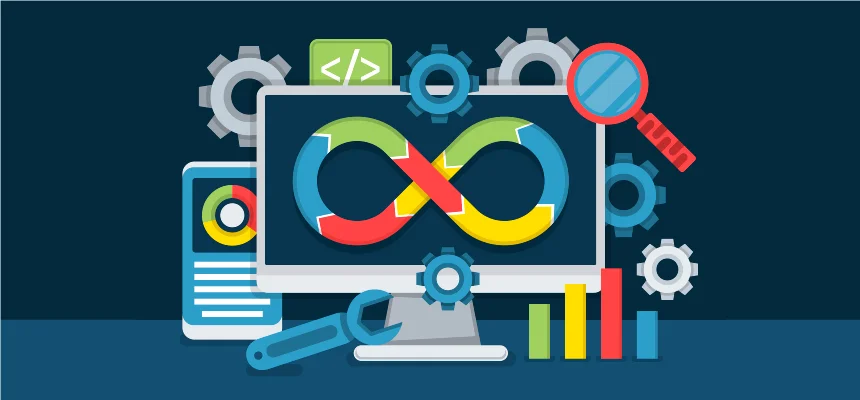In today’s dynamic software development realm, a well-defined and structured approach is crucial for achieving success. The Software Development Life Cycle (SDLC) provides precisely that a systematic framework to navigate the complexities of creating software applications. Within this extensive article, we will explore the 7 fundamental stages of SDLC, along with methodologies such as Agile and Scrum, highlighting the myriad advantages of embracing this approach. Furthermore, we will showcase how Sanmark, a distinguished software development company, can expertly guide you through this journey, ensuring optimal results and successful project outcomes.
What is SDLC?
The Software Development Life Cycle (SDLC) functions as a methodical and structured compass, steering software developers through the intricate design, development, and rigorous testing phases involved in crafting software applications. Acting as a comprehensive roadmap, SDLC meticulously ensures that the resultant software is custom-tailored to meet the precise needs of the client while maintaining stringent industry standards. Each phase within the SDLC is pivotal, serving as a building block for the subsequent steps. This deliberate progression, from the initial concept to the final deployment, is a testament to the meticulous approach, culminating in a well-organised and streamlined development process. It’s within this orchestrated journey that the software product aligns seamlessly with the envisioned goals, delivering optimal results and fulfilling the expectations of stakeholders.
The 7 Stages of SDLC
- 1.Requirements Gathering and Analysis
In this crucial first stage, a thorough and detailed comprehension of the client’s requirements is paramount. Extensive discussions and consultations take place, delving deep into the project’s objectives, target audience, desired features, and essential functionalities. This clear understanding establishes a solid foundation for the subsequent phases of the development process, ensuring a focused and purposeful approach.
Imagine the scenario where the client, a project management consultancy, requires a software tool to streamline their project management processes. Let’s name it “Project Mate”. The requirements-gathering stage involves understanding the client’s needs, such as real-time project tracking, task assignment, and reporting functionalities.
- 2. System Design
Building on the gathered information, this stage involves planning the system’s architecture. The design incorporates the software’s structure, user interface, databases, and system components. A well-structured design facilitates efficient coding and a smoother development process.
In the example, Based on the gathered requirements, the development team envisions the architecture of ”ProjectMate” (Our example). This involves planning the interface, database structure, and system components, ensuring they align with the desired functionalities.
- 3. Implementation (Coding)
During this stage, skilled programmers follow design specifications to write the code, ensuring adherence to coding standards and best practices. The objective is to create robust, scalable software aligned with defined requirements.
During the Implementation stage, where our skilled programmers transform designs into functional software, consider the benefits of hiring Laravel developers. Their expertise ensures that high-quality, scalable applications are developed efficiently, aligning perfectly with client requirements.
In the case of “ProjectMate,” adept programmers meticulously write code, strictly adhering to coding standards. They employ fitting programming languages and frameworks, dedicated to crafting a resilient and easily scalable project management tool.
- 4. Testing
Testing is a pivotal phase, aiming to identify and rectify defects in the software. It encompasses comprehensive testing methodologies like unit, integration, and acceptance testing, ensuring the software aligns with specified requirements.
The testing phase for ”ProjectMate” involves rigorous testing to identify any defects or errors. Testers use different scenarios, testing various functionalities to ensure the software performs as intended, meeting the specified requirements.
- 5. Deployment
The deployment stage involves transitioning the software from development to production, making it accessible to end-users. This phase requires meticulous planning and execution to ensure a smooth transition with minimal disruptions.
Once the testing phase is successful, ”ProjectMate” is deployed, making it accessible to end-users within the project management consultancy. This transition is carefully planned to minimise any disruptions to ongoing projects.
- 6. Operations and Maintenance
Once the software is live, it necessitates continuous monitoring and maintenance to ensure optimal performance. This stage involves addressing user feedback, making necessary updates, and fixing any reported issues to enhance the software’s functionality and usability.
After deployment, the software undergoes continuous monitoring and maintenance. User feedback is collected, and updates are made to enhance ProjectMate’s functionality and usability.
- 7. Evaluation and Feedback
The final stage comprises evaluating the software’s performance in the live environment. Feedback from users is collected and analysed to identify areas for improvement and plan for future updates and iterations.
The final stage involves evaluating ProjectMate’s performance in the live environment. Feedback from end-users is analysed to identify areas for improvement and plan for future updates and iterations.
 https://www.freepik.com/free-photo/working-with-apps-cup-coffee_902754.htm#
https://www.freepik.com/free-photo/working-with-apps-cup-coffee_902754.htm#
Methodologies of Using SDLC - Agile and Scrum:
- Agile Methodology
Agile, a contemporary software development methodology, prioritises flexibility and collaboration, pivotal throughout the project’s evolution. Unlike traditional linear approaches, Agile encourages iterative development and readily accommodates evolving requirements, even in advanced development stages. Rooted in collaboration, adaptation, self-organisation, and customer-centricity, Agile effectively addresses the dynamic nature of today’s software development landscape, ensuring more efficient and satisfying outcomes for both developers and clients.
- Scrum Methodology Scrum, a distinct subset within the Agile methodology, introduces a structured framework that optimises the development process. The project undergoes segmentation into manageable units called sprints, typically ranging from two to four weeks. Each sprint orchestrates a meticulously planned series of activities encompassing daily stand-ups, focused development, thorough testing, and a comprehensive review. This iterative and well-organised approach within sprints significantly contributes to a focused and efficient product development lifecycle.
Benefits of SDLC
The Software Development Life Cycle provides a multitude of benefits that significantly contribute to successful project outcomes:
- 1. Improved Project Management
SDLC, with its structured approach, significantly supports project managers in efficient planning, seamless coordination, and effective control throughout the development process.
- 2. Enhanced Product Quality
By adhering to a methodical approach, SDLC guarantees the creation of dependable, top-notch software that aligns precisely with the expectations set by the client.
- 3. Efficient Resource Utilisation
Thoughtful resource planning and allocation in every stage ensure efficient resource utilisation, leading to cost-effectiveness and streamlined project execution.
- 4. Cost-Effectiveness
SDLC aids in early issue detection and resolution, curbing the expenses tied to rectifying errors during the later stages of development.
- 5. Greater Customer Satisfaction
An organised development process, yielding a superior product, elevates customer satisfaction and augments the credibility of the software and the development team.
Outline
When talking about SDLC and creating new solutions, Sanmark Solutions can not be missed as it is a reputable figure in the software development sphere that prioritises integrating the best SDLC practices, specifically Agile and Scrum methodologies, to guarantee successful project outcomes. Our extensive track record in delivering superior software solutions further distinguishes them in the industry.
For tailored software solutions and expert industry insights, we invite you to engage with Sanmark. Stay updated on the latest advancements in the software industry by subscribing to the Sanmark newsletter. Contact us today to discover how Sanmark can assist you in achieving your software development goals. Partner with us for a rewarding software development journey.
Feature image sources: https://www.freepik.com/free-vector/flat-design-technology-devops-illustration_24746653.htm#
